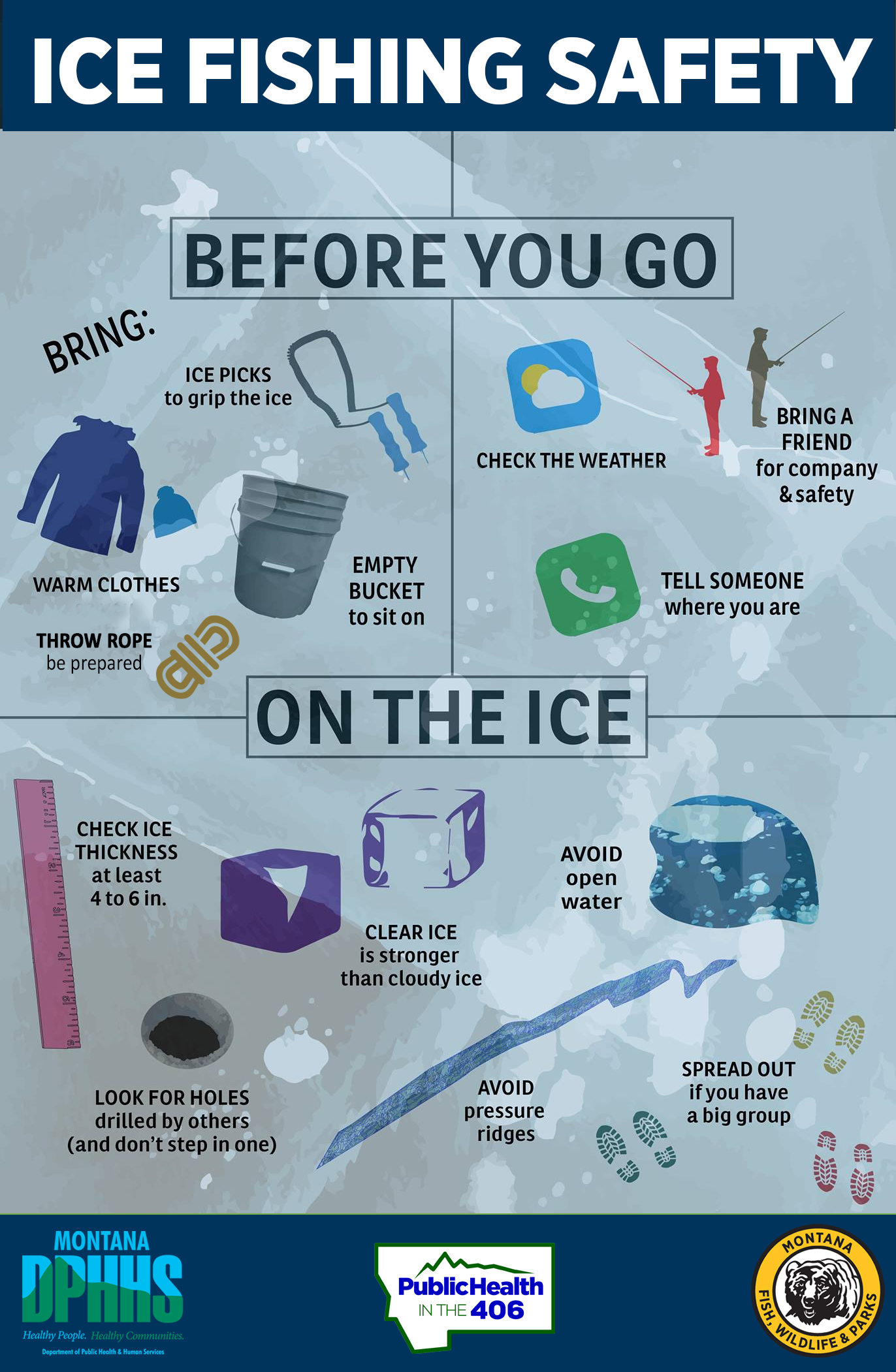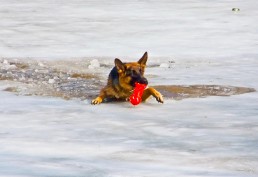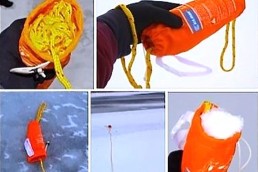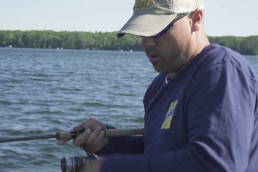Ice Rescues Aren’t Just for Other Anglers
SHARE THIS POST
Back in the early 2000s, my dad and I helped rescue a golden retriever that broke through the ice.
Watching through the windows of my grandparent’s lake house, we had seen two anglers gingerly walk out across the ice, tapping a spud bar atop it to make sure the ice was safe. But when they reached the visible rim of new ice that had formed the night before, the bar poked through, as expected. They immediately backed off and began retreating to shore… but the exuberant dog accompanying them kept on frolicking forward, until crunch, it punched through.
We immediately called the fire department, which informed us that they were not allowed to send the rescue squad out on a non-human emergency. But if someone else fell through, call back.
A whirlwind of frenzied activity ensued. We grabbed jackets and headed down toward the lake. Along the way, my dad said that we should grab an old ladder plopped up against the house. And a spud bar from beneath the porch.
Simultaneously, one of the ice anglers ran 200 yards back toward shore, toward a 12-foot aluminum boat turned upside down for the winter. As he did, the boat owner, who had also seen the calamity unfold, emerged from the house. The two turned the boat right-side up and started hauling it out across about 6 inches of “safe” ice. Meanwhile, the lone angler stood at the rim of the safe ice, verbally encouraging the dog to somehow climb out across perhaps 25 feet of inch-thick, very breakable ice.
As we all converged on the scene with our various rescue gear, the two anglers hopped into the boat with the rope, plus our spud bar and ladder, and the rest of us pushed the boat out onto the thin ice until it punched through. Immediately, they began crunching their spud bar through the ice at the bow of the boat, trying to open a lane and reach the struggling dog. It was tough sledding, attempting to pull against the adjacent thin ice with the spud bar to move the boat forward.
After a couple minutes, they were able to proceed about halfway to the dog before they began running out of steam. Meanwhile, the golden was unsuccessfully trying to get and keep one paw up on top of the ice. Running out of strength, it finally just rested its chin atop the rim, out of options.
Out of desperation, ingenuity is born.
My dad suggested sliding the 8-foot ladder from the boat, across the ice, out to the dog. As they did, it slid out far enough for the last one foot to extend into the hole.
The exhausted dog responded, slowly getting its chin atop the end rung. Then one paw. Next, the other. Then it reached forward with one leg and hooked its elbow (aka cubitus; I looked it up.) over the last rung. After a brief rest, it tried with the other leg, and got the other elbow hooked over the rung. It hung there, out of strength and moves.
Problem was, no one had thought to tie a rope to the other end of the ladder! There was still about 5 feet of thin ice between the bow of the boat and the near end of the ladder. And the boat wasn’t moving to close the gap.
Inspiration struck! Fortunately, our spud bar, homemade by a friend of my grandfather, had a short “T” section extending about 1 1/2-inch to either side of the end of the handle. Reaching the spud bar out over the bow, the angler up front was barely able to slip the “T” over the nearest rung of the ladder, hooking it. He then began to slowly, hand-over-hand the ladder in toward the boat.
Are you enjoying this post?
You can be among the first to get the latest info on where to go, what to use and how to use it!

As he did, the dog managed to remain in place, still lodged atop the last rung by its elbows. (In the days before smart phones, no one thought or had time to find a camera to record this.) Little by little, the ladder pulled the dog up out of the hole, onto the thin ice. Further hauling brought it up alongside the boat. Very carefully, the two anglers managed to shift their weight and lift the dog up into the boat without capsizing.
The rescuers literally weren’t out of the water yet, however. They tossed one end of a rope—I can’t remember who brought it or where it came from—back to the three of us atop the safe ice, and we managed to pull the rescue craft up to the safe edge. Working together, we managed to get everyone back onto firm ice, including the nearly unconscious dog.
Despite pleas to let someone younger (me) carry the 80-pound dog back to shore, Dad immediately lifted it across his chest, began trudging to shore, and made it all the way up the hill, into the house, to warm up the dog. I was picturing my mom never forgiving me if he had a heart attack, but he never wavered, and made it OK.
Meanwhile, a couple of the remaining guys hauled the boat back to shore where it had been, carried the miscellaneous rescue gear back up to our house, and they all enjoyed a shot of brandy—including the dog—to help warm up. Within a few minutes, the dog began recuperating. And we were able to call the rescue a success.
Thinking back on this experience, we were all fortunate—and a bit crazy—to pull this off. If we hadn’t had all the people and miscellaneous rescue devices available—and the dog hadn’t instinctively reacted as it did—things could have gone much worse. And we might have been panic-calling the rescue squad again.
To say that this activity left me with a healthy respect for ice safety is no joke. A lot of folks obliviously wander out onto thin ice with no clue as to potential calamities, unprepared with the proper equipment and the wherewithal to react positively should disaster strike. It’s always best to know, and prepare, before you go.
Chances are that you won’t be carrying a ladder on your next early-ice fishing trip. But a rope, ice picks to help you crawl out of a hole, a spud bar to test the ice ahead of you, life jackets or flotation suits should all else fail, and other safety gear aren’t just advised, but mandatory.
Keep abreast of forming ice conditions. Scan ahead of your approach and evaluate visible signs of potential danger, like pressure cracks. Never travel under bridges or through other constrictions where moving water thins ice. Rivers and river mouths are never completely safe. Stay away from springs or marked areas where ice conditions are unsafe or suspect. Don’t drive machines or vehicles across the ice until it’s more than safe. Plan ahead, act safely, and keep your wits about you.
Spend enough time on the water (and ice) over many years, and you’re bound to encounter situations that unexpectedly go south, even when your head is in the game and the horizon appears safe and secure. I know experienced folks who have gone through the ice, some of whom didn’t make it back out alive. Look in the haunted eyes of survivors who were unable to help their friends in time, and you’ll understand that you never want to be in their boots.
As winter deepens, ice conditions typically become much safer. But then again, when spring thaw draws nearer and ice begins pulling away from shore, take things seriously. You don’t want to sink your vehicle through thinning ice just a few feet offshore, even though the ice looks—and remains—thick just a short distance farther out. Nor errantly step across an open-water gap, out to the ice edge, and then suddenly slip down between the ice sheet and shore. The only reason one friend survived this situation is that he reached his rod, which he was still clutching in one hand, up through the surface, and his buddy pulled him back up by the rod tip!
Also remember that, along the warmer southern fringe of the Ice Belt, ice fishing is a shorter-term, “sometimes thing” to be enjoyed—cautiously. The ice here never really gets safe enough to be what you’d term fully safe, even in a cold winter.
Debbie downer? Not really. Just a realistic perspective based on experience. Ice fishing can be fun, productive and exciting if approached properly. But never take ice safety for granted.
MWO
SHARE THIS POST
Did you enjoy this post?
You can be among the first to get the latest info on where to go, what to use and how to use it!
Dave Csanda
Dave Csanda has enjoyed 40 years in the fishing communications industry at In-Fisherman, Angling Edge and now, as editor of MidWest Outdoors. He is an inductee of both the Minnesota and National Fresh Water Fishing Halls of Fame.



